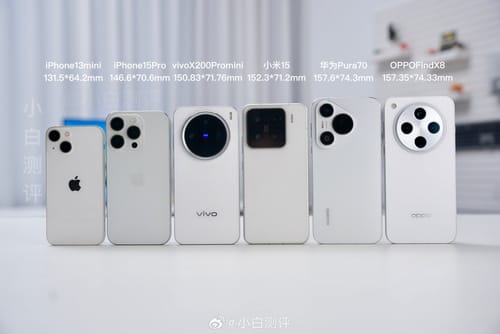The smartphone industry is shifting toward slim and compact designs, led by companies like Apple, Samsung, and Google. As consumers demand more portable devices, these tech giants are rethinking the trend of oversized phones. Smartphones are getting slimmer and smaller again. Companies like Apple and Samsung are developing slim models while brands like Vivo, Xiaomi, and Google are to push compact designs to meet the demand for compact devices.
This is not the first time.
The concept of small and light phones is not new. For instance, Apple did get its hands dirty with small and compact phones before. Their Mini lineup mainly focused on packing most flagship features into a compact body, but that did not go well for Apple.
The first truly compact iPhone from Apple, the iPhone 12 mini, only accounted for about 6% of total sales in the first two months of its release. Despite these low sales figures, Apple still gave the Mini iPhone one more try with the iPhone 13 mini, which followed the same fate as its predecessor and accounted for only 3% of total iPhone sales in the first quarter of 2022.
Bad sales figures reflected how poorly the phone was performing. It had next to no battery life, an underwhelming display, and issues such as overheating and throttling. These things kept customers worried about their daily experience and kept them from getting one.
The aftermath of thin sales and device issues hampered the tech giant’s image. So Apple decided to end the mini lineup, with the iPhone 13 mini being the last one in the family, and replaced it with Plus-sized iPhones moving forward.
Apple did not abandon the small phone entirely, which lives in the form of the base iPhone. Likewise, the Galaxy S series also has a small phone.
Recently, however, we’ve been picking up solid evidence from trusted sources such as Bloomberg’s Mark Gurman about a thin, light, and compact iPhone in the upcoming iPhone 17 series.
Will this be a trend or another transient launch?
According to the leaks, the iPhone 17 Air will be 5.5mm thin, with a 6.6-inch display, similar to the Plus model. But that is not the only thin phone we are having this year. Samsung also showcased its take on slim phones with the upcoming Samsung Galaxy S25 Edge first at the Unpacked event in January and then at MWC25, Barcelona. According to leaks, it will feature a 6.6-inch display and be around 5.8 mm thick.
None of these two phones are compact by any means, as both phones are rumored to feature over 6.5-inch screen real estate. If you’re one of those consumers making the shift to compact flagships from large phones and don’t want to go over the 6.5-inch screen size, then you’re in for a treat. With significant developments in display and battery technology, we’re blessed with phones featuring 6.1-6.3-inch display sizes packed in a handy, pocket-friendly form factor.
Lesser known brands, such as Tecno, have been treading cautiously in the territory, relying on concept devices, rather than actual phones. But, does this mark the emergence of a new trend? Or is just another passing fad?
Slim or short, what will you choose?
Slim phones like the Galaxy S25 Edge and the iPhone 17 Air have yet to make their way to the market. However, we already have some great phones in a compact form factor from brands like Apple, Samsung, Vivo, and Xiaomi, which are doing very well.
The 6.1-inch iPhone 16 has already secured the #1 spot on the top-selling smartphone lists in multiple regions. At the same time, Android flagships with 6.1- and 6.3-inch screen sizes, like the Samsung Galaxy S25, Xiaomi 15, and Vivo X200 Pro mini, are also doing well.
Not just flagships, but even in the midrange segment, the Pixel 9a and iPhone 16e, the latest offerings from Google and Apple, share almost the same specs sheet as their flagship counterparts, with some caveats, all in a smaller footprint, making them a good deal at $500 and $600.
As consumers shift from large glass slab smartphones and technology develops, offering more screen aspect ratio and larger battery capacity, we expect to see more compact midrange and flagship offerings in the future and this trend to continue.
Recent industry surveys also hint at consumers waiting for adequately powered compact flagship phones that do not cut back on power. Will that be a reality? We can't say for sure, but it surely looks like it.
Which form factor will be your next phone?
The mobile industry is ever-evolving. It is made to be dynamic and fast-moving by design. But is there room for another form factor? The possible answer lies in the compromises phone companies will make with each model.
As we see more positive development in display and battery technology, I am sure my next smartphone will feature a slim or compact form factor. What will be your next smartphone? A slim, compact, or perhaps a folding one?

